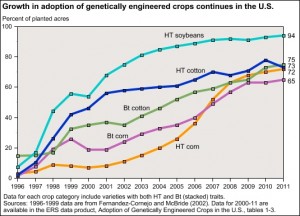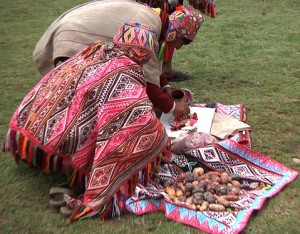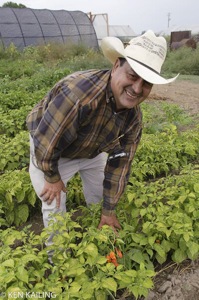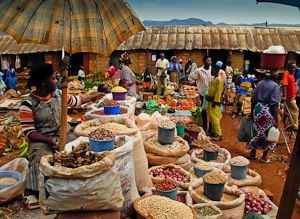We took GoodFood World on the road this week and it gave us a chance to discuss the big news of the last week: the alternative food system’s response to an article that appeared in the New York Times, Genetically Engineered Food for All, by Nina V. Fedoroff. Ms. Federoff was the science and technology adviser to the secretary of state from 2007 to 2010, and is a professor of biology at Pennsylvania State University.
Spending hours behind the wheel of a car passing through the farms and ranches of eastern Washington offers uninterrupted time to examine more closely the idea that we can create grains like corn and soybeans, and other genetically modified foods, which will allow us to increase production and bring down costs in order to “feed the world” in the coming decades of population growth and climate change.
Another salvo across the bow of agro-ecology and the organic movement, the article is just part of a propaganda blitz that has been going on for years, paid for – of course – by Big Ag and Big Food. We’re seeing the biggest pro-GMO effort yet, to move us to a technology-based, corporately controlled, and manipulated food system.
Let’s take a close look at exactly what some of the huge amount of corn and soybeans grown in the US – by Big Ag – is actually used for.
 Corn: 44% goes for animal feed, 30% goes for ethanol, 6% for sweeteners and the remainder (including a fraction of a percent eaten as fresh sweet corn) goes to cereals, starch and “beverage alcohol.” A large percentage of the corn planted every year is genetically modified; 72% is modified to be herbicide tolerant (Ht) and 65% is modified to be insect resistant (Bt). Be aware that much of the genetically modified corn has both traits.
Corn: 44% goes for animal feed, 30% goes for ethanol, 6% for sweeteners and the remainder (including a fraction of a percent eaten as fresh sweet corn) goes to cereals, starch and “beverage alcohol.” A large percentage of the corn planted every year is genetically modified; 72% is modified to be herbicide tolerant (Ht) and 65% is modified to be insect resistant (Bt). Be aware that much of the genetically modified corn has both traits.
Soybeans: 59% of the soybean harvest is crushed for oil (the meal left from that crush is used as animal feed) and 90% of the oil is edible oils, 6% is used for seed, animal feed, industrial uses, and human food other than oil. Soybeans show the highest adoption of genetically engineered crops of those grown in the US; 94% of all soybeans are herbicide tolerant (Ht).
In a 2006 revue of Seed to Seed, Colin Tudge of The Guardian (UK) says:
Crops have been improved enormously these past few thousand years by breeding, which traditionally meant selecting the ones that grow the best, and then “crossing the best with the best and hoping for the best.” The science of genetics, initiated by Gregor Mendel, hugely advanced the efficiency of breeding; and formal plant physiology helps things along even more, as breeders can now envisage the mechanisms that lie behind the changes they effect. For decades the John Innes Centre was publicly owned and dedicated to British and world agriculture. Making better crops is a necessary and noble pursuit – and as the climate changes, we will need a lot more, often novel, kinds, and quickly. Genetic engineering, astutely deployed, could help to push things along.
But in these vile times the best ambitions are corrupted so that now nothing is deemed worthwhile unless it makes rich people richer and powerful governments more powerful. The crops that find their way to the market are of the kind that only the mega-companies can engineer, while farmers, pressured by corporate-friendly governments, are obliged to grow them whether or not they are good for humanity or for the countryside. Thus, even here, in the study of wayside weeds, we see both the power and the ambivalence of science – on the one hand vital to our survival (providing the know-how that enables us to feed ourselves), and on the other the means by which control can be exerted from above. So science can liberate us as nothing else can but also, alas, it is the natural agent of fascism.
Here we are 5 years later and the New Green Revolution is running into trouble. Farmers are facing a new breed of super weed that has developed its own “herbicide tolerance,” the old-fashioned way: selective breeding. There are now 10 resistant species in at least 22 states infesting millions of acres, predominantly soybeans, cotton and corn.
A new report by the Union of Concerned Scientists, Failure to Yield, evaluates the performance of genetically engineered crops. And these high-tech seeds are getting a failing grade. The authors say, “Based on [the] record, we conclude that GE has done little to increase overall crop yields.” But they certainly have increased the sales of Monsanto’s Roundup herbicide! Monsanto garnered revenues of $10.5 billion in 2010, and more than 10% net profits. Roundup represents about 10% of the company’s revenue.
GE soybeans have not increased crop yields, and GE corn has increased yield only marginally. Over the last 15 years, corn and soybean yields have risen substantially, but not because of genetic engineering but because of traditional breeding or improvement in agricultural practices.
Not only are genetically engineered crops failing to deliver on the promise of increased yield, the millions of gallons of herbicide tilled into the soil before planting and sprayed on crops after they have sprouted is causing damage to the soil itself and draining into waterways and leeching into water tables.
While Monsanto is not the only manufacturer of herbicides, it is one of the largest. And upwards of 200 million pounds of glyphosate are applied to American farmlands every year.
USDA scientist Dr. Robert Kremer, has found that glyphosate’s side-effects in the ground are far more severe than previously thought. The use of glyphosate causes:
- damage to beneficial microbes in the soil increasing the likelihood of infection of a crop by soil pathogens
- interference with nutrient uptake by the plant
- reduced efficiency of symbiotic nitrogen fixation
- overall lower-than-expected plant productivity
 Continuing to grow monocrops of corn and soybeans drenched in herbicide that is supposed to kill all other plants, is reducing biodiversity and the resilience of seed stocks. There are continuing examples of traditional and ethnic agricultural practices – including seed saving – that make it possible to grow more food at a lower cost.
Continuing to grow monocrops of corn and soybeans drenched in herbicide that is supposed to kill all other plants, is reducing biodiversity and the resilience of seed stocks. There are continuing examples of traditional and ethnic agricultural practices – including seed saving – that make it possible to grow more food at a lower cost.
A recent report from the International Assessment of Agricultural Knowledge, Science and Technology for Development evaluates the relevance, quality and effectiveness of agricultural knowledge, science, and technology.
Organic agriculture, a “neo-traditional food system” that merges science and traditional farming practices, has the potential to contribute to sustainable food security by reducing input costs dramatically, improving household nutrient intake, and potentially helping mitigate the effects of climate change.
 Here are three fine examples of good implementation of traditional farming practices to increase crops – potatoes grown in Peru using traditional agricultural practices, peppers grown in Washington using organic farming practices, and changes in agricultural techniques in Africa.
Here are three fine examples of good implementation of traditional farming practices to increase crops – potatoes grown in Peru using traditional agricultural practices, peppers grown in Washington using organic farming practices, and changes in agricultural techniques in Africa.
The International Potato Center in Lima Peru has in its gene bank nearly 7200 varieties of potato and 8026 varieties of sweet potato in storage.
Patriarch and “Pepper Master,” Hilario Alvarez, his wife, his 9 children, their spouses and children, myriad cousins, aunts and uncles, and a small contingent of seasonal workers pick, pack, and sell more than 400 varieties of vegetables including 200+ varieties of peppers, 50+ varieties of tomatoes, 20+ varieties of eggplant, summer squash of every size and shape (13 kinds of zucchini), melons, and winter squash. Read the details in Picking Purple Peppers.
 Located in the “hinge” of sub-Saharan West Africa, Cameroon is home to about 19 million people. Because the country’s natural resources are suited to agriculture, an estimated 70% of the population farms. As in all of Africa, vegetation in the region is complex and rich in its biodiversity.
Located in the “hinge” of sub-Saharan West Africa, Cameroon is home to about 19 million people. Because the country’s natural resources are suited to agriculture, an estimated 70% of the population farms. As in all of Africa, vegetation in the region is complex and rich in its biodiversity.
The cropping systems that evolved are also complex; a smallholder farmer may grow ten or more endemic species and varieties within species in his or her garden and fields. See some of the variety of crops in Food, First Hand in Cameroon.
Clearly, “[in] order to address the roots of hunger today and build a food system that will feed the future, we must invest in ‘sustainable intensification’ – not expensive GMO technology that threatens biodiversity and locks us into dependence on fossil fuels, fossil water, and agrochemicals.” (Anna Lappé, Why GMOs Won’t Feed the World – Despite What You Read in the New York Times)
________________________________________
Sources/Resources:
New York Times: Genetically Engineered Food for All
Grist: Why GMOs won’t save the world
Seed Banks – Our Insurance Policy for Food
USDA: Adoption of Genetically Modified Crops in the US
University of Wisconsin, “Toward a Sustainable Agriculture”
New York Times: Farmers Cope With Roundup-Resistant Weeds
GRIST: USDA downplays own scientist’s research on ill effects of Monsanto herbicide
The Guardian (UK): Genes by the wayside, a review of Seed to Seed: The Secret Life of Plants, by Nicholas Harberd
Washington Post: Peru Celebrates Potato Diversity, Monte Hayes
